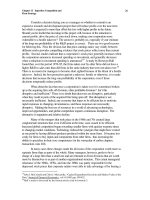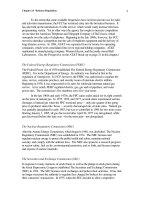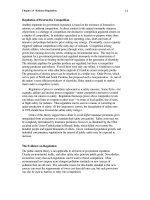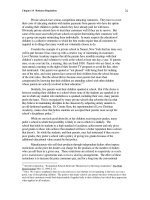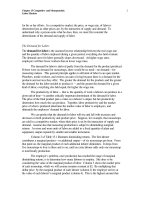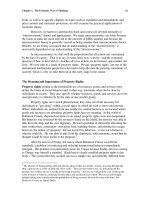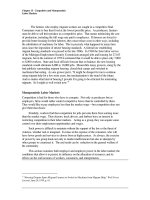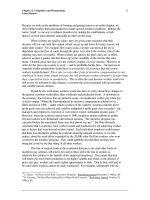Microeconomics for MBAs 4
Bạn đang xem bản rút gọn của tài liệu. Xem và tải ngay bản đầy đủ của tài liệu tại đây (46.99 KB, 10 trang )
Chapter 1. The Economic Way of Thinking
30
restaurants have depended upon the quality of their burgers and the cleanliness of their
rest rooms.
Some firms have failed not because they have done anything “wrong,” but rather
they have not done as much “right” as have their competitors. Many textile firms in the
southeast part of the country have folded over the last two decades in spite of their
substantial efforts to improve their productivity and increase quality. The failing firms
closed their doors simply because they were not able meet the competition from lower-
priced textile imports and from textiles produced by even more aggressive (and
successful) domestic textile firms.
29
Many firms have failed because they did not pay attention to their costs or
because their managers were not very smart in setting their firms’ product and service
strategies to meet the changes in their markets. Even the 9/11 ctatrophy, several major
airlines (and scores of smaller ones) have folded their wings over the last two decades
because their planes and personnel were too expensive relative to the value of the service
they provided and therefore relative to the prices they could charge in deregulated skies.
We agree that a lot of things are important to success in business, not the least of
which are the leadership of managers, worker skills and character, firm strategies, and
cost-control methods. One of the more important points managers must remember is that
incentives can be very powerful forces within a firm—for good and bad! This means
managers must pay attention to the art and logic of getting incentives right. In the
“Manager’s Corner” sections that are included in every chapter, we will examine a large
number of different questions related to the organization of production within firms, most
of which relate to incentives in one way or another: How large should firms be? Do
workers want tough bosses? Why don’t more firms pay piece rate? What difference does
debt make? What good are corporate raiders? At the most obvious level, these questions
are concerned with widely different problems firms have to face. But underneath all that
is written about firm structure or piece-rate pay or corporate raiders in the “Manager’s
Corner” sections is an important theme: Develop incentives so that everyone in your firm
or connected to it—owners, executives, managers, workers, suppliers, and customers—
win from your firm’s operation.
It is all too common for people to think that the only way for one group of
“stakeholders” in a firm to gain is for some other group to lose. The search is all too
frequently for ways to cut costs for one group of stakeholders (owners or managers) by
skewering another group (line workers or customers). In this book we seek incentive
arrangements by which everyone profits. That means that we seek incentives that are
mutually beneficial, which necessarily means incentives that promote cooperation
between everyone with an interest in the firm. Devising mutually beneficial incentives is
a tough order, but we think it is the only way to ensure a viable business. Business
arrangements that do not benefit all parties involved are arrangements that are not likely
to survive for long.
29
Indeed, many textile firms have failed because the expanding nontextile economies of their regions have
pushed up labor costs, outcompeting some textile firms for the resources they need for continued
production.
Chapter 1. The Economic Way of Thinking
31
As noted, we typically think of firms competing with each other by producing
better products at lower costs and making them more conveniently available to
consumers at lower prices. But underlying this competition that we can observe in the
marketplace is a more fundamental struggle taking place within firms to organize
production in the most efficient manner, which necessarily requires an understanding of
the incentives that face firm stakeholders—owners, managers, workers, and suppliers.
The “Manager’s Corners” have been written with one central proposition in mind: In the
competitive marketplace, the firms that survive and thrive are the ones that recognize that
incentives matter—and they matter a great deal. Successful firms play to the power of
smart incentives (those that drive firm and worker incomes upward) and avoid perverse
incentives (ones that undermine firm and worker incomes). And managers have good
reason to make incentives a major focus for their firms: They can reduce their chances of
being replaced.
30
Why Incentives Are Important
But such facts beg a critical question, Why are incentives important? Why do
they work? Admittedly, the answers are many. One of the more important reasons that
incentives matter within firms is that firms are collections of workers whose interests are
not always aligned with the interests of the people who employ them, that is, the owners.
The principal problem facing the owners is how to get the workers to do what the owners
want them to do. The owners could just issue directives, but without some incentive to
obey the directives, nothing may happen. Directives may have some value in themselves;
people do feel a sense of obligation to do what they were hired to do, and one of the
things they may have been hired to do is obey orders (within limits). However, directives
can be costly. Firms may use incentives simply as a cheaper substitute for giving out
orders that can go unheeded unless the workers have some reason to heed them.
Firms may also use incentives to clarify firm goals, to spell out in concrete terms
to workers what the owners want to accomplish. As every manager knows all too well,
it’s difficult to establish and write out the firm’s strategy that will be used to achieve its
stated goals, and it is an even more difficult task to get workers to appreciate, understand,
and work toward those goals. The communication problem typically escalates with the
size of the organization. Goals are always imperfectly communicated, especially by
memoranda or through employment manuals that may be read once and tossed. Workers
don’t always know how serious the owners and upper managers are; they can remember
any number of times when widely circulated memos were nothing but window dressing.
Incentives are a means by which owners and upper managers can validate overall
company goals and strategies. They can in effect say through incentives, “This is what
we think is important. This is what we will be working toward. This is what we will be
trying to get everyone else to do. And this is where we will put our money.” Even if
30
According to econometric research, those firms in the lowest decile of industry performance measured by
profit and stock price increases were about 1.5 times as likely to have a change of top executives as firms in
the best decile of profit and stock price performers. See M. Weisback, “Outside Directors and CEO
Turnover,” Journal of Financial Economics, vol. 20 (1988), pp. 431–60; and J. Warner, R. Watts, and K.
Wruck, “Stock Prices and Top Management Changes,” Journal of Financial Economics, vol. 20, pp. 461–
92.
Chapter 1. The Economic Way of Thinking
32
workers were not sensitive to the pecuniary benefits of work, but were only interested in
doing what their companies wanted them to do, incentives, because of the messages they
convey, can have a valued and direct impact on what workers do and how long and hard
they work.
31
But there is a far more fundamental reason that incentives matter: Managers don’t
always know what orders or directives to give. No matter how intelligent, hard working
and well-informed managers are, they seldom know as much about particular jobs as
those who are actually doing those jobs. Knowing about the peculiarities of a machine,
the difficulties a fellow worker on the production line is experiencing at home, or the
personality quirks of a customer are just a few examples of the innumerable particular
bits of localized knowledge that are crucial to the success of a firm. And this knowledge
is spread over everyone in the firm without the possibility of its being fully
communicated to, and effectively utilized by, those who are primarily responsible for
managerial oversight. The only way a firm can fully benefit from such localized
knowledge is to allow those who possess the knowledge—the firm's employees—the
freedom to use what they know.
Management theorists are increasingly recognizing this simple fact—that a great
deal of knowledge is widely dispersed throughout the firm. In doing so, they are turning
away from the approach to management recommended by Frederick Taylor.
32
At the
beginning of the twentieth century, Taylor had popularized the time-and-motion approach
to management in which experts, or managers, determined the most efficient way to do
particular jobs and then required employees to work accordingly. Instead of the top-
down or command style recommended by Taylor, the management profession is now
sympathetic to a more participatory managerial approach, under which the management
hierarchy is flatter, with authority for particular decisions dispersed throughout the firm,
residing with those who are in the best position to exercise it. As noted, in varying
degrees, all firms are necessarily involved in participatory management with practically
everyone having some management authority over some firm resources. The principal
difference between those workers at the top and bottom of the firm hierarchy is the scope
of authority over resources.
But the benefits from participatory management can only be realized if employees
have not only the freedom but also the motivation to use their special knowledge in
productive cooperation with each other. The crucial ingredient for bringing about the
requisite coordination is incentives that align the otherwise conflicting interests of
individual employees with the collective interests of all members of the firm. Without
such incentives, there can be no hope that the knowledge dispersed throughout the firm
will be used in a cooperative and coordinated way. The only practical alternative to a
31
This perspective on incentives is developed by Harrison C. White, “Agency as Control,” Principals and
Agents: The Structure of Business, edited by John W. Pratt and Richard J. Zeckhauser (Boston, Mass.:
Harvard Business School Press, 1991), pp. 187–12; and James A. Robins, “Why and When Does Agency
Theory Matter? A Critical Approach to the Role of Agency Theory in the Analysis of Organizational
Control” (Irvine, Calif.: Graduate School of Management, University of California, Irvine, working paper,
1996).
32
Frederick Taylor, The Principles of Scientific Management (New York: Harper, 1929).
Chapter 1. The Economic Way of Thinking
33
functioning system of incentives is, again, a top-down, command-and-control approach
that, unfortunately, can never allow the full potential of a firm's employees to be realized.
Managers must heed the words of social philosopher Friedrich Hayek, “The more
men know, the smaller the share of knowledge becomes that any one mind [the planner's
mind included] can absorb. The more civilized we become, the more relatively ignorant
must each individual be of the facts on which the working of civilization depends. The
very division of knowledge increases the necessary ignorance of the individual of most of
this knowledge.”
33
That insight applies within the firm. With the growing complexity
and sophistication of production, knowledge becomes ever more widely dispersed among
a growing number of workers. Hence, the importance of incentives has grown with
modern-day leaps in the technological sophistication of products and production
processes. Incentives will continue to grow in importance as production and distribution
processes become ever more complex.
Seen in this light, the problem of the firm is the same as the problem of the
general economy. As did Hayek, economists have argued for years that no group of
government planners, no matter how intelligent and dedicated, can acquire all the
localized knowledge necessary to allocate resources intelligently. The long and painful
experiments with socialism and its extreme variant, communism, have confirmed that this
is one argument that economists got right. But the freedom for people to use the
knowledge that only they individually have has to be coupled with incentives that
motivate people to use that knowledge in socially cooperative ways—meaning that the
best way for individuals to pursue their own objectives is by making decisions that
improve the opportunities for others to pursue their objectives. In a market economy
these incentives are found primarily in the form of prices that emerge out of the rules of
private property and voluntary exchange. Market prices provide the incentive people
need to productively coordinate their decisions with each other, thus making it not only
possible, but desirable, for people to have a large measure of freedom to make use of the
localized information and know-how they have.
A perfect incentive system would assure that everyone could be given complete
freedom because it would be in the interest of each to advance the interests of all. No
such perfect incentive system exists, not within any firm or within any economy. In
every economy there is always some appropriate mix of both market incentives and
government controls that achieve the best overall results. The argument over just what
the right mix is will no doubt continue indefinitely, but few deny that both incentives and
controls are needed. Similarly, for any firm made up of more than one person, there is
some mix of incentives and direct managerial control that best promotes the objectives of
the firm; i.e., the general interests of its members.
Granted, incentives may not seem to matter much at any point in time, but even
so, the power of incentives can accumulate with time. For example, suppose that without
improved incentives firm profits will grow in real-dollar terms by 2 percent a year.
Suppose that with more effective incentives firm profits can grow by 2.5 percent a year.
The difference is not “much,” just a half of a percentage point per year. However, the
compound impact of the higher growth rate will mean that after 30 years, real profits will
33
F. A. Hayek, The Constitution of Liberty (Chicago: University of Chicago Press, 1960), p. 26.
Chapter 1. The Economic Way of Thinking
34
be 33 percent higher with the improved incentives (a fact that is likely to be reflected in
current stock prices). Furthermore, the firm may be able to achieve the relatively higher
profits with little or no cost. “Good” incentives may be no more expensive than “bad”
incentives. Good incentives are the proverbial “free lunch” that economists typically
dismiss.
Of course, if a given firm doesn’t pay attention to its incentives, it may lose more
than its lunch; it may be forced out of business by those firms that do recognize the
importance of incentives. Seen from this perspective, incentives can be a critical
component of firm survival, perhaps just as critical as product development or
technological sophistication.
The problem is in getting the incentives right and using the full range of potential
incentives. Unfortunately, we can’t say exactly what incentives your firm should
employ. The exact incentives chosen depend on local conditions that can vary greatly
across firms. You would not want us to write about particular incentives for your
particular circumstances, mainly because we can be assured of only one constant fact
about business: Particular circumstances will change with time and markets. Here, we
offer a way of thinking about incentives that, if employed with diligence, will enable
managers and owners to get their firms’ incentives more in line with their desire for
increased productivity and profits.
Why Designated Hitters Get Hit
Admittedly, there is no way that managers can ever know for sure what the best set of
incentives is. The problems of determining the proper incentives are many. And one of
the main problems is not the dearth, but the great variety of incentives that can be used.
Under the “Manager’s Corner” sections, we necessarily focus on monetary incentives.
This is mainly because such incentives have been well tested, but monetary incentives
should be expected to be effective for the broad sweep of managers and workers: Most
people can usually find some reason to want more money, given that it can be used to buy
so many things that people want. But our emphasis on monetary incentives doesn’t mean
that money is all that matters to people at work, and managers should realize that simple
fact. Managers need to know what counts. We know money should count for most
people at work simply because money can be used to buy so many things that are valued
by workers. But what attributes of work can count? That’s not always an easy question
to answer. Not recognizing the question, however, and not looking for answers can have
incentive consequences that are not expected.
To see this point, we take a sports example that involves people at work, albeit
baseball players. Starting in 1973, the American League allowed “designated hitters” to
bat for pitchers (who are, generally, poor at batting). What would you expect to be the
consequence of such a workplace change? Three economists have reasoned that given
that American League pitchers would not come up to bat, we should expect that more
batters would be hit by errant pitches in the American League than in the National
League. This is because the American League pitchers would not have to fear being hit
themselves in retaliation. Hence, American League pitchers could be expected to
deliberately hit more batters or to take more chances of coming closer to batters than
